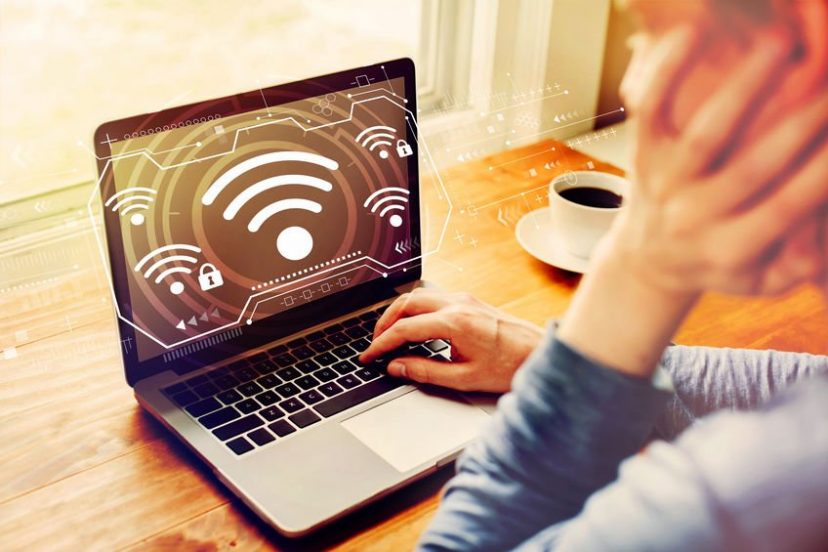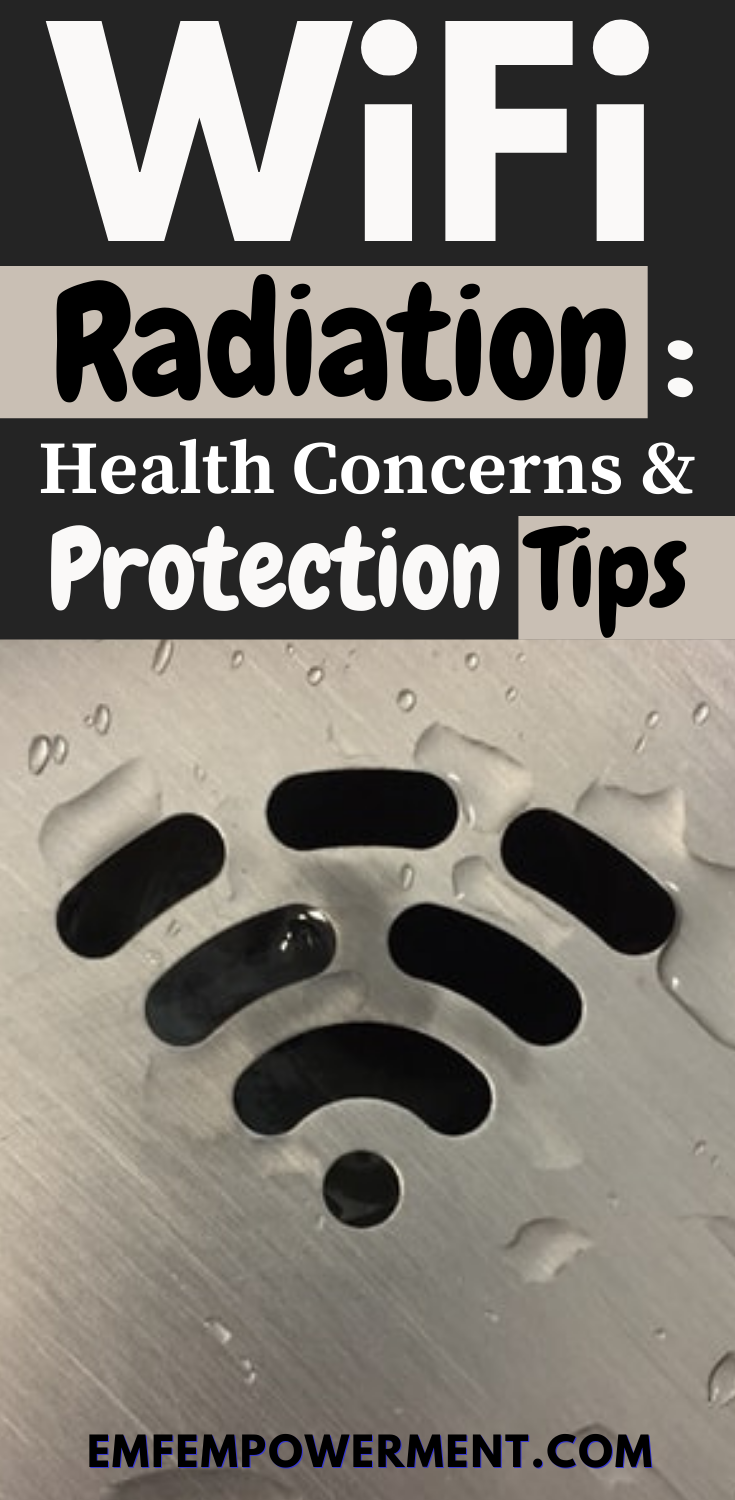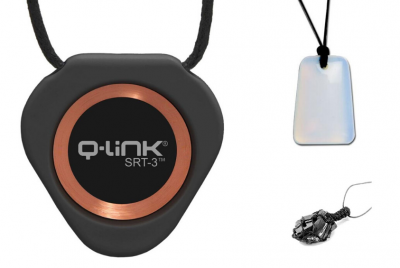When worn correctly, both Bluetooth and wired earbuds offer a lightweight and comfortable way to listen…
WiFi Radiation: Health Concerns & Protection Tips

*We may earn a commission for purchases made using our links. Please see our disclosure to learn more.
In the United States, it is estimated that at least 89% of households with broadband internet use WiFi. The technology allows users to connect a virtually unlimited number of devices, all wirelessly. And while it is certainly convenient, it’s worth pointing out that serious safety concerns related to WiFi do exist.
For one, your information is less secure than with a wired connection. This is doubly true if you are using a connection that isn’t password-protected, such as a public network.
In addition to data theft, there is also the possibility of negative health effects due to WiFi signals, and that is what we are going to focus on here. In this guide, we will talk about WiFi radiation and the impact of exposure. We will also discuss tips for measuring WiFi radiation in your own home, and go over a few things you can do to protect yourself.
How WiFi works
WiFi requires the use of three devices: a router, a modem, and a receiver. There can be multiple receivers, but typically a network uses only one WiFi router and modem.
Your modem uses a wired connection to access the internet. It then sends that data via an ethernet cable to your wireless router. The WiFi router transmits that data via your home’s WiFi network, where it is picked up by a receiver, such as the one built-in to your laptop computer. From the receiver, the data is translated and able to appear on your screen. Receivers can send data out, as well, which is picked up by the WiFi router and sent back to the modem.
Over the years, WiFi has adhered to 802.11 networking standards, although they have evolved over the years to allow for faster data transfer speeds. Currently, we use 802.11ac, while 802.11ax began its rollout in 2019. The newer version offers significantly faster speeds.
Regardless of the standards adhered to, the signal sent out by your WiFi router and receiver is a radiofrequency signal. WiFi signals generally transmit in the 2.4GHz or 5GHz range, depending on your router. On the electromagnetic spectrum, radiofrequency waves fall on the non-ionizing side, which means that unlike X-rays and ultraviolet light, they lack the energy necessary to split an atom. Nonetheless, WiFi and other radiofrequency waves are a form of EMF radiation.
Is WiFi radiation harmful?
Radiofrequency (RF) EMF radiation is recognized by the World Health Organization’s International Association for Research on Cancer as possibly carcinogenic to humans. While more research into the issue is warranted, the WHO felt that the designation was reasonable given the association between cell phone radiation and the development of gliomas — a rare and deadly brain tumor — in rats.
WiFi itself hasn’t been extensively studied, but some research into the subject does exist. One of the more valuable bodies of research is a 2017 literature review of existing studies done by Martin L. Pall, a researcher at Washington State University. Pall examined a selection of studies into the health effects of WiFi radiation exposure. He found that there were seven health effects, in particular, that were associated with exposure.
These health effects include DNA damage, alterations in sperm count and quality, neurological issues, cellular death, issues with calcium levels, effects on the endocrine system, and oxidative stress. These findings are very much in line with other research into RF-EMF radiation, in general. To learn more, visit the Top 30 Studies on EMF Radiation.
Exposure to WiFi radiation is also associated with the appearance of Electromagnetic Hypersensitivity symptoms in sensitive individuals. Just like WiFi, much more research into EHS is warranted. Nevertheless, some sufferers do state that they are affected by the presence of WiFi radiation. Possible side effects of exposure in those with EHS include dizziness, nausea, headaches, and fatigue.
How to measure WiFi radiation
RF-EMF radiation from your WiFi network can be detected by certain EMF meters. Any meter will do, so long as it is capable of detecting radio frequencies. Typically, we recommend the TriField TF2, although our guide to The Best EMF Meters For Any Budget has a few additional recommendations if you don’t already have a meter of your own.
Once you’ve secured your EMF meter, the next step is to do the actual testing. Stand directly next to your WiFi router, and power the device off. Take your first reading with your EMF meter and make a note of the results. Then, power the WiFi router back on and take another reading in the same location. Notice the difference. You can repeat this process at various distances from the router, including in different rooms of your house.
It is also worthwhile to take readings next to your WiFi-enabled devices, both with and without WiFi turned on. For example, take a reading next to your cell phone while it is connected to your home’s WiFi network. Then, take a reading at the same approximate distance, but with the phone’s WiFi turned off.
This exercise can give you an idea of just how much WiFi radiation you and your family are exposed to at home. It can also give you some idea of how to tackle your WiFi problem, and what devices, specifically, may need your attention. If the levels in your high-traffic living areas and bedrooms are within a safe range, you might be fine not doing anything. However, if you found unsafe radiation levels present in important areas of your home, you may want to take action.
Tips for protecting your home
To reduce WiFi radiation at home, your absolute best bet is switching to an entirely wired network. This requires a bit of work, but there are some definite advantages. For one, it offers a more secure connection that is less prone to data breaches. And, perhaps most relevant to the topic at hand, it virtually eliminates your exposure to WiFi radiation.
Going from WiFi to a wired connection involves using ethernet cables to hook-up every device in your home that requires an internet connection. The cables run from the devices directly to the modem, eliminating the need for a WiFi router. At most, you may require an ethernet switch, such as Netgear’s 8-Port Gigabit Ethernet Unmanaged Switch.
For more information on establishing a wired connection for your home, see How to Switch From WiFi to Wired Internet.
Additionally, you could install a WiFi router guard. These are devices that enclose your router, acting as a Farraday cage and keeping radiation from spreading throughout your home while still allowing a WiFi signal to pass through. See WiFi Router Guard: How It Works And Why You Need One to learn more.
You can also try simple lifestyle modifications to reduce your overall WiFi exposure. These involve turning your home’s WiFi off at night when it’s not in use, and downloading games and media to your phone, tablet, or laptop so they can be accessed while WiFi is powered off. It is also advisable to avoid the use of WiFi extenders, if possible. These devices help increase the range of your home’s WiFi signal, but that also means additional areas are exposed to WiFi radiation. Rather, try and keep your WiFi signal confined to as small of a range as possible.
It’s also possible that some of the WiFi radiation present in your home is the result of a neighbor’s WiFi signal. If that is the case, determine which areas of your home are within range of your neighbor’s network. Then, use EMF paint or an EMF shielding barrier on any walls inside of that range.
Final thoughts
WiFi radiation is present in every home that uses WiFi, and even some that don’t. It may seem like an inescapable part of life, but there are steps you can take to eliminate — or at least reduce — your exposure. 



